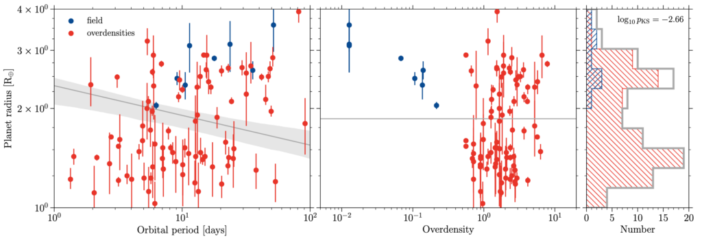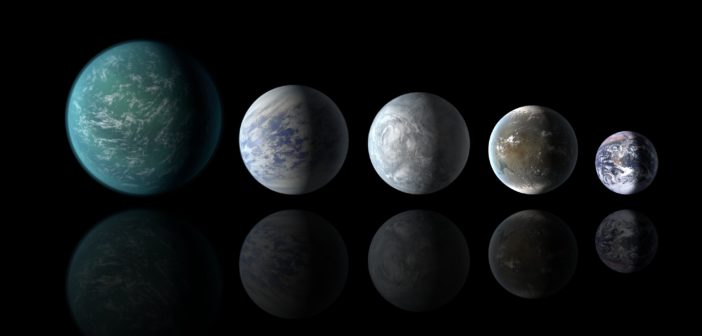Editor’s note: Astrobites is a graduate-student-run organization that digests astrophysical literature for undergraduate students. As part of the partnership between the AAS and astrobites, we occasionally repost astrobites content here at AAS Nova. We hope you enjoy this post from astrobites; the original can be viewed at astrobites.org.
Title: Bridging the Planet Radius Valley: Stellar Clustering as a Key Driver for Turning Sub-Neptunes into Super-Earths
Authors: J. M. Diederik Kruijssen, Steven N. Longmore, & Mélanie Chevance
First Author’s Institution: Center of Astronomy, Heidelberg University, Germany
Status: Published in ApJL
Neptunes and Jupiters and Earths, Oh My!
Extrasolar planets, or exoplanets, have been theorized for centuries, and studied firsthand since the 1990s. Much of the common classification of exoplanets is based on analogs in our own solar system: hot Jupiters, super-Earths, and super-Jupiters, just to name a few. The authors of today’s paper focus on two types of exoplanets: super-Earths (planets with more mass than Earth but less mass than Neptune) and sub-Neptunes (planets of 1.7–3.9 times the size of the Earth, but with a composition similar to Neptune’s).

Figure 1: A histogram of planets with given radii from a sample of 900 Kepler systems. The decreased occurrence rate between 1.5 and 2.0 Earth radii is apparent. [Fulton et al. 2017]
Compiling the Sample
The authors analyze a sample of exoplanets from the NASA Exoplanet Archive with radii of 1–4 Earth radii and orbital periods of 1–100 days. These radii and periods are chosen so that they only analyze planets that have had these values directly measured rather than derived from mass–radius relationships. The density of stars around the planet’s host star is part of the archival data, and the sample is split into “field” and “overdensity” subgroups that consist of low stellar density and high stellar density host star regions, respectively. In this case, what constitutes low and high densities is determined by the probability of there being many stars within 40 pc of the system: field stars have an 84% probability that there aren’t many neighboring stars, and overdensity stars have an 84% probability that there are. Additionally, only systems with ages of 1–4.5 billion years are considered, since younger systems may not be stabilized and the overdense group is too small in older systems. Finally, they constrain the host star mass to 0.7–2.0 solar masses to limit the chance of observing effects that are actually caused by mass differences rather than stellar clustering. With these cuts, the authors are left with 8 field planets and 86 overdensity planets, for a total of 94.
Results

Figure 2: Left: The orbital periods and radii of the planets. The radius valley is marked with the black line, and its uncertainty is given by the grey stripe. Center: The planetary radii versus the density of their stellar fields, with the grey line representing a constant radius. Right: A histogram of how many planets have each radius. Note that the radius is plotted on a logarithmic scale in all three panels. [Kruijssen et al. 2020]
Simply plotting the densities and radii suggests that the authors’ idea holds up (Figure 2). In the middle panel, the gray line represents a constant radius within the radius valley. The fact that there are fewer planets around this line shows the radius valley exists, but how does that prove their idea? The field stars all lie above the radius valley, while a little more than half of the overdensity stars lie below the radius valley. If residing in a dense field can cause dynamic and radiative effects that decrease the planet’s radius, having more small planets in overdense regions is expected.
But what if it’s really the effect of some other properties of the systems? Comparing the planets’ host star masses, metallicities, and ages shows no clear differences that might suggest the trend is caused by one of those characteristics. This data is compiled in Table 1. But what about the distance from Earth to the system? The further from Earth a system is, the less likely we are to be able to observe smaller planets. Could that be a factor skewing the numbers, since that could mean we just aren’t seeing the smaller planets? On average, the field systems are closer to Earth, but all of their planetary radii lie above the valley. The authors therefore conclude that the distance is probably not a contributing factor either.

Table 1: Characteristics of the sample planets. The authors split the sample into three groups: field planets, overdensity planets with radii above the radius valley, and overdensity planets with radii below the radius valley. The median stellar masses, metallicities, ages, and distances from Earth for each group are given with their uncertainties. The authors conclude that these values are all close enough to suggest that they are not the cause of the radius valley. [Kruijssen et al. 2020]
But what about those other mechanisms we discussed earlier? The authors consider photoevaporation within the system, mass loss, and rocky formation alongside the potential effects of densely clustered stars near the system. They conclude that stellar clustering alone can’t be responsible for the trends seen in planetary radius, but alongside one of the other three theories, clustering is certainly a potential contributor to the radius valley. The clustering would, however, affect each of the three scenarios differently. For the rocky core mass loss scenario, it is unlikely that clustering has any direct effect, since that mechanism is purely internal to the planet. The likelihood of rocky planet formation, on the other hand, can be increased by clustering effects, since neighboring stars could cause photoevaporation within the protoplanetary disk. This would decrease the amount of gas in the disk, increase the dust-to-gas ratio — the ratio of solid particles to gaseous particles in the disk — and thus increase the likelihood of rocky formation. Additionally, clustering could cause more stellar encounters with the system, which in turn could change the orbits of the planets and the effects of photoevaporation inside the system.
In this paper, the authors conclude that, in addition to previous theories, the dynamic and photoevaporative effects of stars near planetary systems can contribute to the radius valley between super-Earth and sub-Neptune exoplanets. Although this doesn’t provide definite answers to why this valley exists, it provides another piece to the puzzle. Solving the mystery of this radius valley can give us more insight into planetary formation mechanisms in extrasolar systems.
Original astrobite edited by Mike Foley.
About the author, Ali Crisp:
I’m a third year grad student at Louisiana State University. I study hot Jupiter exoplanets in the Galactic Bulge. I am originally from Tennessee and attended undergrad at Christian Brothers University, where I studied physics and history. In my “free time,” I enjoy cooking, hiking, and photography.
